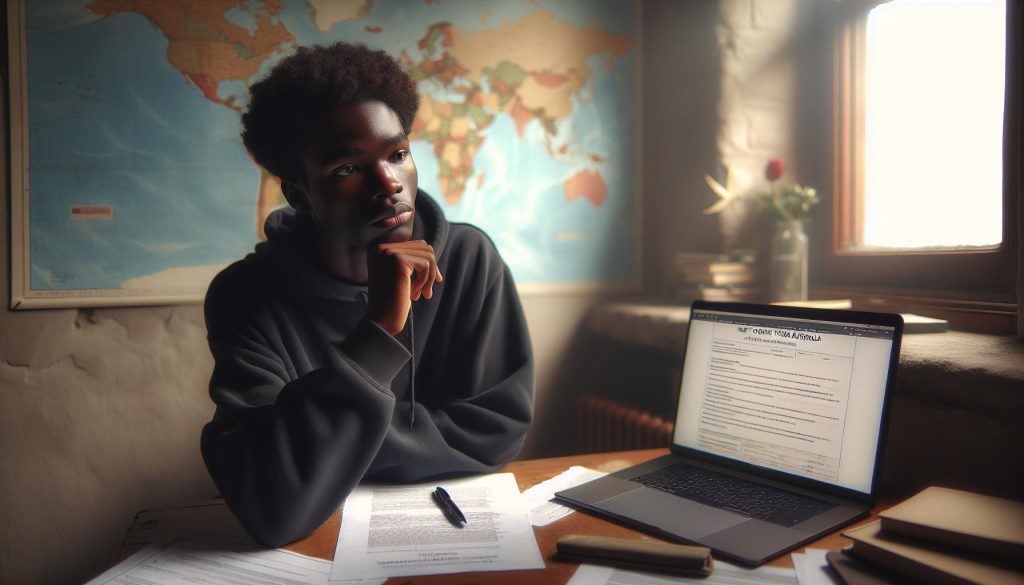Navigating the complexities of studying abroad can sometimes lead to tough decisions, like the need to cancel a student visa in Australia. Whether due to a change in academic direction, personal circumstances, or simply completing your studies, understanding the withdrawal process is crucial for ensuring a smooth transition. This guide will walk you through the necessary steps to cancel your student visa effectively, addressing common concerns and providing the clarity you need. Discover how to manage your visa status while keeping your future goals in sight, and learn about the implications of your decision. By empowering yourself with the right information, you can take control of your journey and make informed choices that align with your aspirations. Keep reading to explore the detailed process and know that you’re not alone on this path.
Understanding the Basics of Student Visa Cancellation
Navigating the complexities of a student visa cancellation can be daunting, especially for international students aiming to make the most of their educational journey in Australia. A student visa is not just a gateway to studying in a foreign land; it embodies the hopes and aspirations that many students carry with them. Understanding the basics of visa cancellation is therefore critical, as it can significantly impact both your academic future and financial standing.
When a student visa is cancelled, it typically reflects various underlying issues, including failure to comply with visa conditions, academic progress, or changes in personal circumstances. It’s essential to stay informed about the reasons for visa cancellation, as they can range from academic deficiencies to issues with enrollment status. For many students, receiving a Notice of Intention to Cancel or a decision notice from the Department of Home Affairs can be overwhelming. During this period, it’s crucial to seek clarity, understand your rights, and know the steps you can take to mitigate potential consequences.
A proactive approach is key. Maintaining open communication with your educational institution can help address issues before they escalate. Schools often have resources dedicated to assisting students facing visa or academic challenges, offering both guidance and support. It is advisable to familiarize yourself with the withdrawal process, which includes notifying relevant authorities, submitting necessary documentation, and ensuring compliance with any academic requirements to avoid penalties. Understanding these essentials can empower you to make informed decisions, ultimately leading to better outcomes, whether you choose to appeal the cancellation, explore other visa options, or transition into different studies in Australia.
Reasons for Cancelling Your Australian Student Visa
Navigating your educational journey in Australia can be an enriching experience, but it’s crucial to understand some of the challenges that may arise, including the potential cancellation of your student visa. Student visa cancellations can happen for a variety of reasons, and knowing these can help you avoid pitfalls that may derail your academic pursuits.
One major reason for cancelling a student visa is non-compliance with visa conditions. This includes failing to maintain enrollment in a registered course, not attending classes regularly, or not achieving satisfactory academic progress. For instance, if you accumulate too many absences or receive unsatisfactory grades, your education provider might notify the Department of Home Affairs, which can lead to a Notice of Intention to Cancel your visa.
Another prevalent issue is changes in personal circumstances. Life events such as illness, financial difficulties, or family emergencies may affect your ability to study and comply with visa requirements. If you need to leave Australia for an extended period or switch your program of study without notifying the relevant authorities, this could trigger a cancellation process. Furthermore, applying for a different type of visa, such as a visitor visa, while holding a student visa can also result in complications that lead to cancellation.
In some cases, students may unintentionally provide false information or fail to disclose necessary details during their visa application or renewal process. This can also lead to a cancellation since honesty is paramount when dealing with immigration matters. If you find yourself in a situation where you might face visa cancellation, it’s essential to reach out to your educational institution for support and to consider consulting with legal professionals who specialize in immigration issues. By understanding the reasons behind visa cancellations and taking proactive steps to address potential issues, you can help safeguard your studies and future plans in Australia.
Step-by-Step Guide to the Withdrawal Process
Navigating the withdrawal process from your student visa in Australia can be daunting, but understanding the steps involved will help ease the transition. Whether you’re considering cancellation due to personal circumstances, academic challenges, or other reasons, following a structured approach is essential for ensuring that everything is handled smoothly.
To start the withdrawal process, it’s important to notify your education provider. This involves formally informing them of your decision to cancel your student visa. Be proactive and schedule a meeting with your student adviser or contact the international student office. They can provide you with tailored guidance and discuss the implications of your visa cancellation on your enrollment status and any remaining commitments.
Next, you will need to complete and submit a visa cancellation form to the Department of Home Affairs. Depending on the situation or your education provider’s request, this form can often be found on their website or obtained directly through their office. Make sure to include all necessary details about your current visa status and any supporting documentation that highlights your reasons for cancellation. Timeliness is crucial here, so try to submit this form as soon as you’ve made your decision.
It’s also beneficial to keep detailed records of all communication related to your visa cancellation. Save copies of emails, meeting notes, and forms you submit. This not only helps in maintaining clarity of your situation but also serves as a reference should any issues arise in the future.
Finally, following your application for cancellation, ensure that you monitor your email and any correspondence from the Department of Home Affairs. They will notify you once your visa has been officially canceled, and it’s important to stay informed about any further action or implications regarding your status in Australia.
By following these steps carefully, you can navigate the withdrawal process with confidence and clarity, minimizing stress and uncertainty during this transition period.
Essential Documents Required for Visa Cancellation
When it comes to canceling your student visa in Australia, having the right documentation is crucial for a smooth process. The documents you submit help clarify your intentions and ensure that your cancellation is processed efficiently. Missing or incorrect paperwork can lead to misunderstandings, delays, or even complications with future visa applications. Therefore, gathering the necessary documentation ahead of time will not only streamline your cancellation but also position you favorably for any future immigration needs.
First and foremost, you will need to complete the visa cancellation form. This form can usually be found on the Department of Home Affairs website, and it requires specific details about your current visa status and personal information. It’s important to fill it out accurately, as errors or omissions can prolong your cancellation process. Along with this form, you may be asked to provide proof of your identity, such as a passport copy or driver’s license. Having these documents readily available will assist in verifying your identity swiftly.
In addition to these primary documents, any supporting materials that explain your reasons for cancellation can be beneficial. For example, if your cancellation is due to personal circumstances or academic challenges, providing relevant documentation-such as medical certificates or letters from your educational institution-can help clarify and justify your decision. Moreover, consider including any correspondence with your education provider regarding your intention to withdraw. This not only shows transparency but can also foster goodwill with immigration authorities.
Lastly, keeping a record of all communications and documents submitted will be invaluable. Creating a folder-whether physical or digital-dedicated to your visa cancellation helps in managing your case efficiently. Documentation prepared and organized in advance will not only ease the cancellation process but also set you up for success in any future endeavors, whether that involves reapplying for a visa or seeking alternate pathways in your educational journey.
By being proactive and thorough with your documentation, you can navigate the complexities of visa cancellation more effectively, allowing you to focus on your next steps with confidence.
Common Mistakes to Avoid When Canceling
Navigating the process of canceling your student visa in Australia can feel overwhelming, especially amid personal challenges or changes in your academic journey. It’s essential to be aware of common pitfalls that could complicate this already delicate situation. By understanding these mistakes, you can better prepare for a smoother withdrawal process and minimize future complications related to visas and your academic standing.
One of the most significant errors students make is underestimating the value of proper documentation. While it’s easy to think that a single form will suffice, the reality is that immigration authorities often require various supporting documents. These may include proof of identity, letters from educational institutions, and any relevant personal circumstances-like medical issues-that necessitate your withdrawal. Failing to submit a complete and accurate set of documents can lead to delays or even a rejection of your cancellation request.
Another common mistake is not communicating with your educational provider. Many students may forget to inform their universities about their intention to cancel their visa, leading to misunderstandings regarding enrollment status. This lack of communication can have repercussions on your academic records or future enrollment possibilities. Always keep the lines of communication open with your institution; provide them with an official notification of your intent to cancel, along with any supporting documentation that might assist in your case.
Timing is also crucial. Waiting too long to initiate the cancellation can result in complications-especially if your visa has already expired. It’s essential to act promptly upon deciding to withdraw. Moreover, failing to understand the implications of your cancellation on work rights or future visa applications can lead to undesirable situations. Always consult up-to-date resources or seek advice from an immigration expert if you’re uncertain.
Lastly, don’t overlook the importance of keeping detailed records of all correspondence and submissions related to your cancellation. A lack of organization can lead to missing vital follow-ups or deadlines, which can hinder the process altogether. With careful attention to these common mistakes, you can navigate the cancellation process more effectively, allowing you to focus on your future academic or career pursuits.
How to Communicate with Immigration Authorities
When it comes to canceling a student visa in Australia, effective communication with immigration authorities is crucial. Being clear, concise, and courteous can significantly impact the outcome of your request. First, ensure that you identify the appropriate channels for communication. Typically, this involves using the official website of the Australian Department of Home Affairs, where you can find the relevant contact details or online forms to submit your request.
It’s essential to provide all necessary information at the outset. Start your communication by clearly stating your name, student visa details, and the reason for your cancellation. Here’s a checklist to ensure you cover all bases:
- Your full name
- Visa reference number
- Email and phone number
- Detailed reason for cancellation
- Documentation support (if applicable)
Keep your message focused. Immigration personnel often deal with many inquiries, so being concise while explaining your situation helps them understand your request swiftly. If your situation involves unique circumstances, it might be beneficial to explain them briefly to clarify your intent.
In addition to written communication, it’s wise to consider following up with a phone call if you do not receive a timely response. Be prepared with your details, and approach the discussion with respect and patience, as the person on the other end can provide essential insights and updates on your application status.
Lastly, keep a record of all communication, including dates and content of conversations or emails. This documentation may prove invaluable in case of any issues or questions regarding your cancellation request. By approaching the communication process thoughtfully, you can navigate your student visa cancellation more smoothly and prioritize your academic journey ahead.
What Happens After You Cancel Your Visa?
Once the decision to cancel your student visa has been made and formally communicated to the appropriate authorities, a series of important steps and considerations follow. Understanding what happens next can help you navigate this transitional phase with confidence and clarity.
Immediately after your cancellation request is processed, you’ll receive a confirmation. This confirmation is crucial, as it signifies the legal termination of your visa status. Depending on your situation, you may have a grace period during which you can remain in Australia. It’s important to verify the specifics of this grace period, as overstaying could have serious repercussions for any future visa applications.
Next Steps to Consider
- Accommodation: Begin making arrangements for your housing situation. If you were living in student accommodations, notify them of your departure. This early communication can prevent unnecessary financial penalties.
- University Notification: Inform your university of your visa cancellation. This will allow them to adjust your enrollment status, ensuring that you are not charged for any upcoming semesters and that your academic records are accurately maintained.
- Financial Matters: Review your financial obligations. Contact your bank or financial institution to discuss any accounts linked to your student status. If applicable, inquire about refunds for tuition fees or accommodations, ensuring you understand any policies regarding reimbursement.
- Future Visa Options: If you plan to reapply for a different visa or extend your stay in Australia under a new arrangement (like a visitor visa or another student visa), start gathering the necessary documentation. Consulting with an immigration advisor can provide insights tailored to your specific circumstances.
Impact on Your Future
It’s essential to consider how canceling your student visa might affect your academic and career prospects. Take inventory of your skills, experiences, and relationships built during your study period, as these can be invaluable assets in your future endeavors. Engage with your university’s counseling services, career center, or alumni network for guidance and support during this transition.
In navigating the aftermath of a visa cancellation, remain proactive and informed. By addressing your accommodation, financial matters, and future plans thoughtfully, you can open new doors for academic and professional opportunities beyond your current visa status. Stay positive and focused on your next steps, whether that means pursuing further education, seeking employment, or exploring different paths altogether.
Reapplying for a Visa: What to Know
Reapplying for a visa after having a previous one canceled can seem daunting, but it is certainly possible with the right approach and understanding of the process. Many students face similar situations, and knowing the key steps can make a significant difference in securing a new visa. Before you dive in, take a moment to reflect on your circumstances and what led to the cancellation of your last visa. Understanding the reasons and addressing any underlying issues will be crucial in your reapplication process.
Firstly, it’s essential to determine what type of visa you intend to apply for. Whether it’s a new student visa, a visitor visa, or possibly even a different category that suits your updated situation, knowing your options can help streamline the process. Gather all necessary documents that illustrate your educational intentions and compliance with visa conditions, such as your university enrollment confirmation, financial statements demonstrating your ability to support yourself, and any additional documents requested by the Department of Home Affairs.
Addressing Previous Cancellation Issues
Be prepared to explain the circumstances surrounding your previous visa cancellation. Clearly outline any steps you’ve taken to rectify issues or comply with previous visa conditions. If you’ve sought academic support or improved your financial situation, include this information in your application. Honesty and transparency will build trust with immigration officials, showing that you are serious about adhering to visa requirements in the future.
Submitting Your Application
When you’re ready to submit your application, ensure that everything is organized and complete. Missing documents or incomplete applications can lead to delays or even rejections. You might benefit from consulting with an immigration advisor who can provide tailored advice based on your specific situation and help you present your case in the best possible light.
Reapplying for a visa can be a significantly different experience than your initial application. Take the time to understand the process thoroughly, stay optimistic, and remember that many students successfully navigate similar challenges. With diligence and preparation, you can position yourself for a fresh start in your educational journey.
Impact on University Enrollment and Studies
The decision to cancel your student visa can have profound implications on your university enrollment and academic journey, whether you’re a domestic or international student. When a visa is canceled, not only does it impact your legal status in Australia, but it may also affect your ability to continue your studies, participate in essential university activities, and access vital resources.
Firstly, immediate enrollment status can be jeopardized upon visa cancellation. Universities often have specific policies regarding the enrollment of students with active visas. If your visa is canceled, you may find yourself in a state of limbo, unable to attend classes or register for upcoming courses, disrupting your academic progression. Keeping open lines of communication with your university’s international office can be crucial. They may offer advice tailored to your situation, such as options for temporary enrollment or understanding the process of transferring to another institution.
Academic and Financial Considerations
It’s important to understand how visa cancellation can impact your academic records and financial obligations. For international students, tuition fees may still be due for the semester, even if you are unable to attend classes. Carefully review your university’s policies on tuition refunds and discuss your situation with the finance department. Failure to manage your financial commitments can lead to further complications, including potential academic penalties.
Furthermore, some students may wonder about the implications for their future educational plans. If you intend to reapply for a new student visa after cancellation, consider how this may affect your academic timeline. You may need to demonstrate to immigration authorities that you have been proactive in addressing any issues leading to the visa cancellation, which may involve additional documentation or changes to your study plans.
Support Networks and Resources
Navigating the aftermath of a visa cancellation can feel overwhelming, but you don’t have to go through it alone. Universities often provide access to support services such as counseling, legal advice, and financial guidance. Engaging with these resources can help you make informed decisions about your next steps. Moreover, peer support groups or student associations can provide a community of understanding and shared experiences, helping you feel less isolated during this challenging time.
In summary, while the impact of student visa cancellation on university enrollment and studies can be significant, being proactive and informed can help manage these challenges effectively. Maintain communication with your university, seek support from available resources, and take steps toward planning your future academic endeavors with clarity and purpose.
Understanding Refunds for Tuition Fees
When facing visa cancellation, understanding the refund process for tuition fees can significantly alleviate financial stress. Many students are often surprised to learn that their eligibility for refunds depends on various factors, including the timing of the cancellation and the specific policies of their institution. Engaging with your university’s financial services office can provide clarity and ensure you don’t miss out on your entitled refunds.
It’s crucial to review the university’s official refund policy, which typically outlines the conditions under which refunds are granted. Generally, refunds might be available if you cancel your visa before the census date, which is the point at which your enrollment becomes official for that semester. Be aware that universities may have different rules for full refunds, partial refunds, or no refunds at all. Here are some steps to guide you through the process:
- Check Eligibility: Confirm if you are eligible for a refund based on when you cancel your visa relative to the census date.
- Collect Documentation: Prepare all necessary documents such as your cancellation confirmation, proof of payment, and any communication with your university.
- Contact Your University: Reach out to the financial services department to discuss your situation and ask questions about your refund status and next steps.
- Submit Refund Request: Depending on your university’s process, you may need to formally submit a refund request form. Ensure you include all required documentation to avoid delays.
It’s advisable to keep a record of every step of your communication, as this can expedite the process and serve as evidence if any issues arise. If you encounter difficulties with obtaining your refund, you may also want to reach out to student support services or seek legal advice to explore your options further.
In addition to the immediate need for financial management after cancellation, consider the potential long-term implications of your tuition fees. Some universities allow students to transfer fees to future semesters or different programs, especially if they plan to reapply for a visa soon. Being proactive and understanding your rights and options will empower you to make informed decisions that can ultimately support your academic journey, whether in Australia or another location.
Exploring Alternatives to Visa Cancellation
The emotional toll of having to consider visa cancellation can be significant, but there are alternatives that may allow you to maintain your status and continue your studies in Australia. Before deciding to cancel your student visa, it’s essential to explore all available options, as they can be more beneficial in the long run.
One potential alternative is to seek advice or assistance from your educational institution. Many universities have dedicated international student services or counselors who can help you navigate visa-related challenges. They may provide resources to resolve academic issues that could be jeopardizing your visa status, such as academic performance or attendance concerns. Engaging with these services early can lead to solutions that keep you enrolled without the need for visa cancellation.
Additionally, if your visa is at risk due to financial difficulties, you may want to explore various financial support options. Many institutions offer scholarships, emergency funds, or payment plans that can help ease your financial burden. Communicating openly with your university about your situation may lead to tailored financial solutions that allow you to continue your studies.
Another alternative is to consider a change in your course or study program. If your current studies are too demanding, switching to a more manageable course load or different field of study can help you maintain your visa status while still pursuing your education goals. It is crucial to discuss such changes with your institution to ensure they align with visa requirements and enhance your overall academic experience.
If personal circumstances like family emergencies or health issues are affecting your ability to stay enrolled, look into options for temporary leave rather than outright cancellation. Some institutions allow students to take a leave of absence, giving you the space needed to resolve personal matters without losing your visa status.
By proactively seeking these alternatives and utilizing the support systems available to you, you may find a path forward that allows you to stay in Australia, complete your education, and avoid the complexities of visa cancellation.
Resources for Support and Guidance During This Process
Navigating the complexities of canceling a student visa can be a daunting process, but there are many resources available to help you through it. Engaging with the right support systems can ensure you make informed decisions and understand your options thoroughly. Whether it’s academic pressure, personal circumstances, or financial difficulties driving your decision, knowing where to turn for assistance is crucial.
Many Australian universities offer dedicated services for their international students, including international student offices, academic advisors, and counselors. These resources are invaluable as they provide tailored guidance based on your unique situation. They can help you explore alternatives to cancellation, such as taking a leave of absence, changing your course, or addressing academic performance issues. The sooner you reach out, the more options you’ll have to maintain your visa status.
In addition to university support, there are community organizations and legal aid services that specialize in immigration issues. These organizations can provide advice on your rights, the cancellation process, and implications for your future in Australia. They may also assist with paperwork and help clarify any legal jargon that can be overwhelming.
Furthermore, it can be beneficial to connect with fellow students who have been through similar experiences. Online forums and social media groups can serve as platforms for sharing advice, emotional support, and practical tips. Engaging with peers who understand your circumstance can alleviate feelings of isolation and provide new perspectives on navigating challenges.
By leveraging these resources and support systems, you can make well-informed choices that prioritize your academic journey and wellbeing, helping to make the process of canceling a student visa less stressful and more manageable.
Frequently asked questions
Q: How do I formally cancel my student visa in Australia?
A: To formally cancel your student visa in Australia, you need to complete a visa cancellation request. This can be done online through the Immigration website, or you can submit a written request to the Department of Home Affairs. Ensure that you state the reasons for cancellation clearly.
Q: What information do I need to provide when cancelling my student visa?
A: When cancelling your student visa, you should provide your visa details, personal identification, and the reasons for the cancellation. It may also be helpful to include supporting documents if applicable. Refer to the “Essential Documents Required for Visa Cancellation” section for more details.
Q: Are there fees involved in the student visa cancellation process?
A: Generally, there are no fees for cancelling your student visa in Australia. However, if you are reapplying for another visa in the future, there may be application fees involved. Make sure to check current policies on the Department of Home Affairs’ website for the latest information.
Q: Will cancelling my student visa affect my ability to return to Australia in the future?
A: Yes, cancelling your student visa can impact your future visa applications. If you have complied with visa conditions, it may not hinder your chances significantly. However, circumstances will be evaluated on a case-by-case basis. Refer to the “Reapplying for a Visa: What to Know” section for guidance.
Q: Can I appeal if my student visa is cancelled?
A: If your student visa is cancelled, you may have the right to appeal the decision. This typically involves applying to the Administrative Appeals Tribunal (AAT). Ensure you seek legal advice and understand the relevant deadlines for lodging an appeal.
Q: How long does the student visa cancellation process take?
A: The cancellation process usually takes a few weeks, but it can vary based on the complexity of your case. Always check the latest processing times on the official immigration website to stay informed.
Q: What happens to my studies when I cancel my student visa?
A: Once you cancel your student visa, your enrollment at the university will typically be terminated. It’s crucial to communicate with your institution about your decision and understand the implications for your studies. Check the section on “Impact on University Enrollment and Studies” for more detailed information.
Q: Where can I find support during the visa cancellation process?
A: There are several resources available for support during the visa cancellation process. You can contact your university’s international office or seek advice from migration agents. The “Resources for Support and Guidance During This Process” section outlines useful contacts and organizations.
Concluding Remarks
Navigating the process of canceling your student visa in Australia can feel overwhelming, but now you have the essential steps to make it smoother. Remember, clarity in your withdrawal process not only ensures compliance with immigration laws but also sets you on the right path for future opportunities. If you have lingering questions, don’t hesitate to explore our in-depth guides on visa applications and university admission processes.
Ready to take action? Dive into our resources on managing student finances or preparing for career prospects, which are invaluable as you transition to the next phase of your journey. Your experience matters-share your thoughts in the comments below and join our community! Whether you’re reconsidering your path or planning your next steps, you’re not alone. With the right support and resources, you can confidently navigate any changes. Stay empowered and continue exploring our site for more tips tailored just for you!









